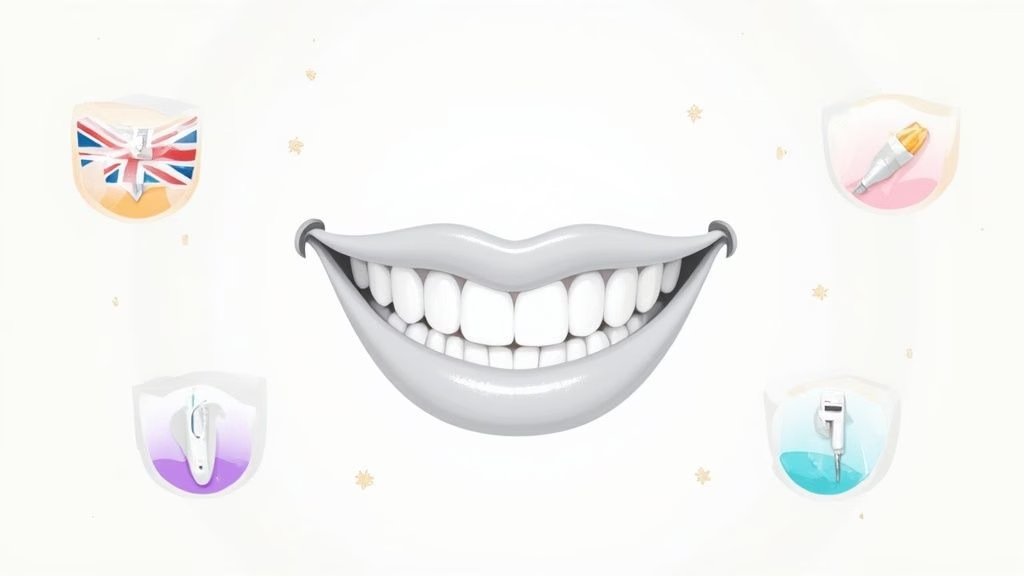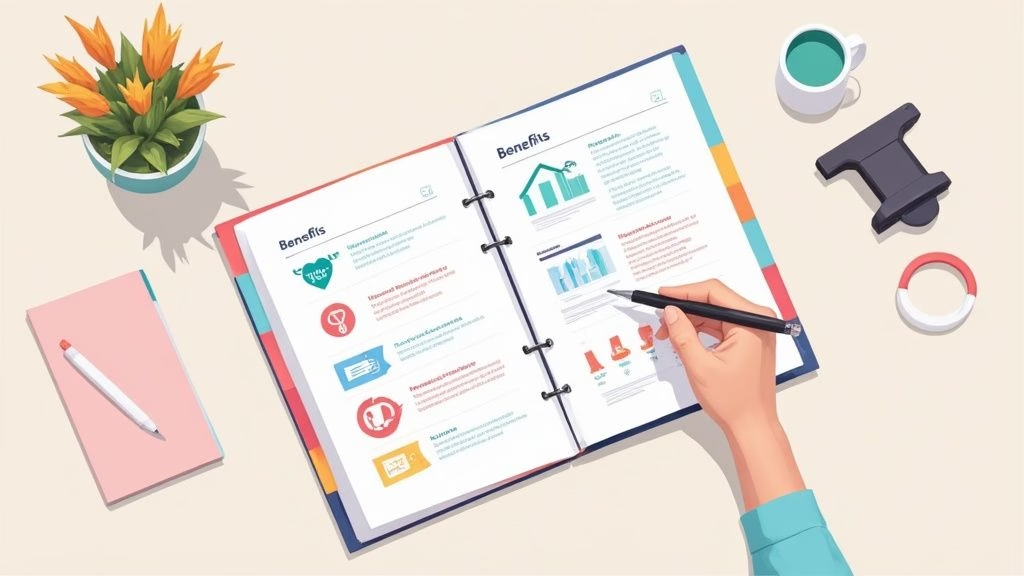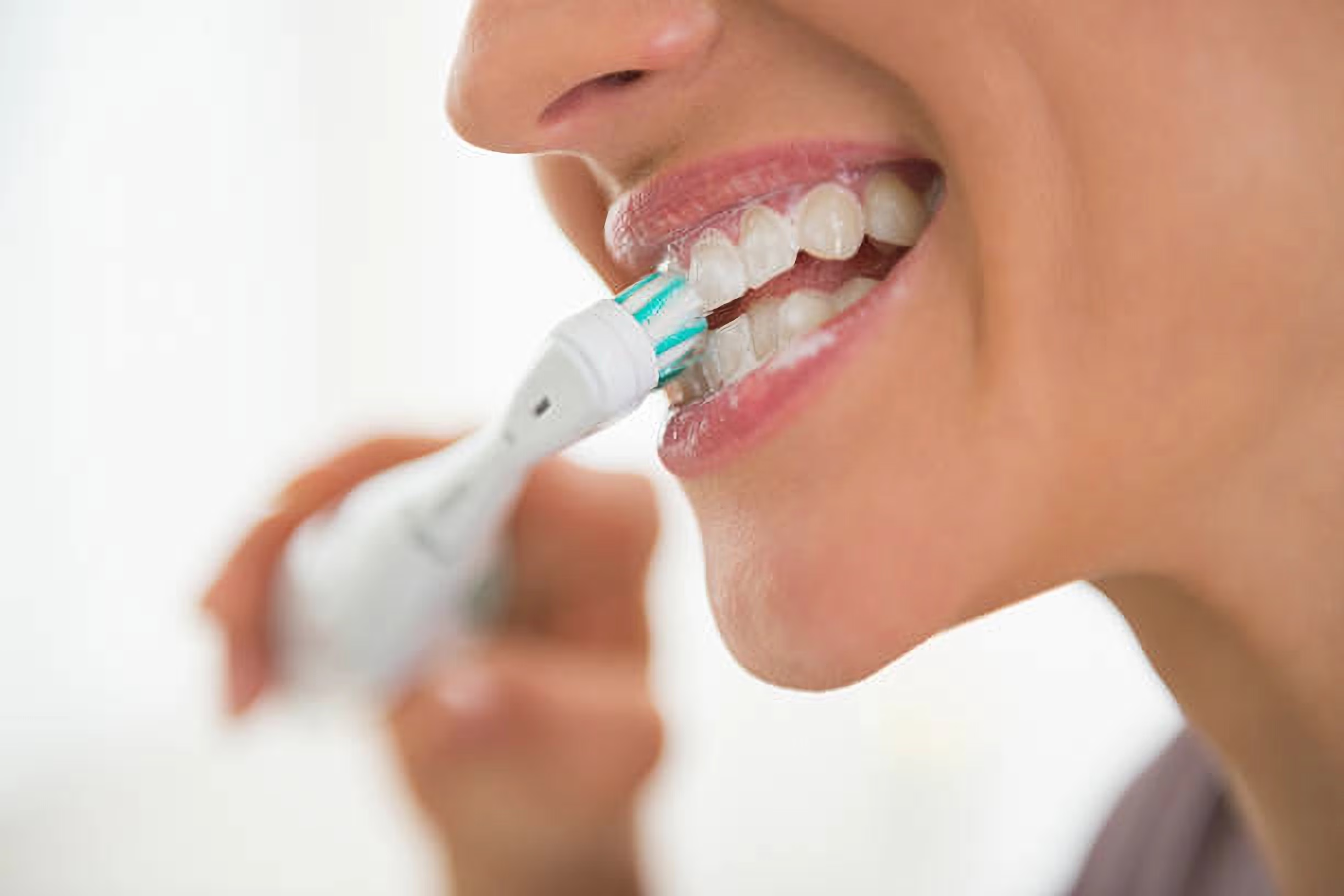Best Teeth Whitening Kits UK for a Brighter Smile
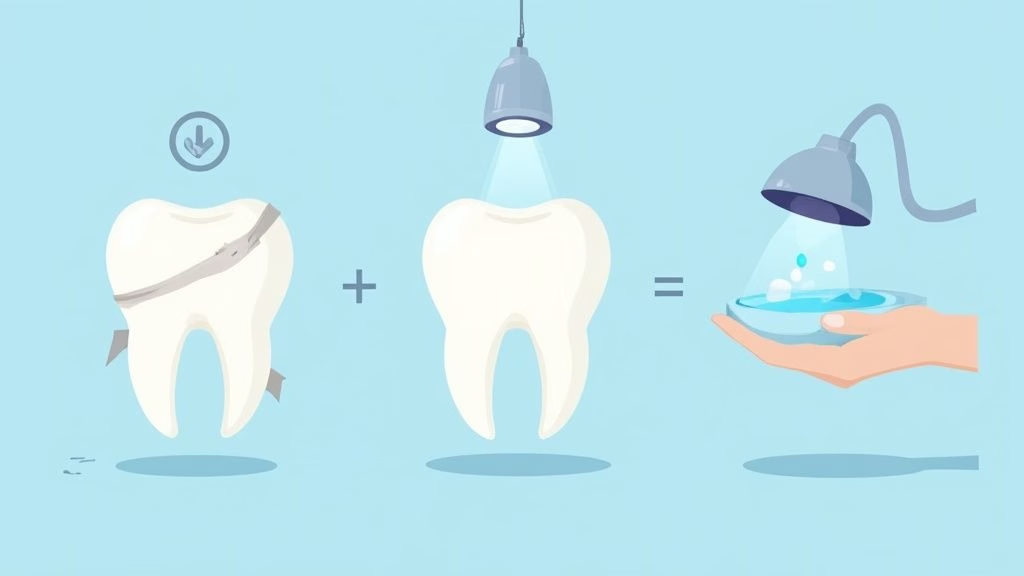
When it comes to getting a brighter smile at home, the best teeth whitening kits in the UK are almost always the ones overseen by a dentist. It’s a simple matter of safety and science—dental professionals can legally provide stronger, more effective whitening agents that you just can't get over the counter.
While shop-bought kits are convenient, professionally guided options like those from Toothfairy offer a different league of results. They’re designed to be predictable and customised, closing the gap between ineffective DIY products and costly trips to the dental clinic. As a modern dental service, Toothfairy provides a smarter and more affordable way to handle not just cosmetic work like whitening, but also teeth straightening and dental emergencies.
Finding the Right Path to a Brighter Smile

Trying to choose a teeth whitening kit in the UK can feel a bit bewildering. The shelves are packed with options, all promising a movie-star smile, which makes it hard to figure out what’s safe, what actually works, and what’s right for you. This guide is here to help you cut through the hype.
We'll break down the real differences between the whitening kits you can pick up at the chemist and the treatments a dentist can guide you through. The aim is to give you the confidence to make a smart choice, armed with a clear understanding of the science, safety rules, and what kind of results you can realistically expect.
The desire for a brighter smile is huge. The UK teeth whitening market hit a value of £196 million in 2023 and is only set to grow, proving just how many of us are looking for a reliable solution.
At-Home Kits vs Professional Guidance
At its core, your decision comes down to one thing: a completely DIY approach versus one that involves a dental professional. Each route has its own pros and cons, suiting different budgets, goals, and expectations. Getting your head around this is the first crucial step towards getting the smile you want without risking your oral health.
| Feature | Over-the-Counter Kits | Dentist-Supervised Systems |
|---|---|---|
| Active Ingredients | Legally capped at 0.1% hydrogen peroxide, often too weak for noticeable change. | Prescription-strength gels (up to 6% hydrogen peroxide). |
| Application Method | Generic strips or ill-fitting trays, leading to patchy results. | Custom-moulded trays made from your unique dental impressions. |
| Safety & Oversight | No professional check to see if whitening is suitable for you. | A dentist confirms your oral health is suitable before you start. |
| Cost | Cheaper upfront, but you might need to buy them again and again. | A higher initial investment for more reliable and lasting results. |
Why Professional Oversight Matters
It’s easy to be tempted by the low price and convenience of a shop-bought kit, but this often comes at the expense of results and safety. One-size-fits-all trays can leak gel onto your gums, causing irritation, while the legally restricted whitening agents are frankly not powerful enough to lift anything more than the most minor surface stains.
This is exactly where modern, dentist-led solutions like Toothfairy have changed the game.
They blend the ease of an at-home kit with the expertise and power of professional dental care. You get access to safe, prescription-strength treatments without the hefty price tag of in-clinic procedures. It’s a balanced approach that puts both your smile and your health first.
As you start thinking about your own journey, you can explore a comprehensive guide to teeth whitening options.
So, How Does Teeth Whitening Actually Work?
Before you start looking at the best teeth whitening kits in the UK, it’s worth understanding what’s really going on when you try to brighten your smile. It's not magic, it's chemistry. Getting your head around the basics will help you see past the clever marketing and pick a product that actually has a chance of working.
Teeth stains generally come in two flavours, and each needs a different game plan. The most common kind is extrinsic staining, which is the stuff that builds up on the surface of your enamel. This is the classic discolouration from your daily habits – coffee, red wine, tea, and smoking are the usual suspects.
Then there’s intrinsic staining. This type of discolouration is much deeper, happening inside the dentin, which is the layer just under your enamel. Intrinsic stains can be caused by ageing, trauma to a tooth, or even certain medications you might have taken as a child. As you can imagine, these deeper stains are a lot tougher to shift and almost never budge with standard shop-bought kits.
The Science Bit: Active Whitening Ingredients
The real work of lifting stains is done by the active ingredients in the whitening gel. In the UK, the two heavy hitters are hydrogen peroxide and carbamide peroxide. When you put them on your teeth, they start a chemical reaction that releases oxygen molecules.
These tiny molecules are small enough to get through the porous surface of your enamel and down into the dentin. Once there, they find the discoloured molecules that cause stains and break them apart, effectively bleaching your teeth from the inside out. This is how you get a genuine, lasting white shade, not just a surface-level polish.
A lot of people think whitening is just about scrubbing the surface of the tooth. But true whitening is a chemical process that happens beneath the enamel, which is why the strength of the bleaching agent is so critical for getting real results.
Why UK Legal Limits Are a Game-Changer
This is where things get really interesting, and the difference between over-the-counter kits and professional treatments becomes crystal clear. UK law is incredibly strict about how much peroxide can be in products sold directly to the public. To keep everyone safe, any at-home kit you buy online or in a shop can legally contain a maximum of 0.1% hydrogen peroxide.
Let's be blunt: that's not enough to make a big difference. That tiny concentration might lift some very light surface stains, but it’s the main reason so many people are left disappointed by shop-bought kits. The active ingredient is simply too weak to deliver the bright, noticeable change they’re after.
A dentist, however, can legally prescribe whitening gels with much, much higher concentrations. For at-home use with custom-fitted trays, they can provide gels with up to 6% hydrogen peroxide. That’s 60 times stronger than what you can buy over the counter. This is the professional-grade strength needed to tackle stubborn extrinsic stains and even make a dent in those deeper intrinsic ones.
These laws are in place for a good reason – your safety. Stronger peroxide gels need a dentist's eye to make sure they're used correctly, avoiding any potential damage to your gums or enamel. It underlines why getting a professional assessment should always be the first step.
This is exactly the gap that services like Toothfairy are designed to fill. By connecting you with a qualified UK dentist, you get safe and legal access to prescription-strength whitening treatments from home. You’re not just buying a product off the shelf; you're investing in a professional process designed for real, visible results, all while keeping your oral health front and centre.
A Detailed Breakdown of At-Home Whitening Kits
Trying to choose an at-home whitening kit can feel like wandering down an endless supermarket aisle. With so many options promising a dazzling smile, it’s tough to know what actually works, especially with the UK’s strict rules on whitening ingredients.
The desire for a brighter smile from the comfort of home is bigger than ever. During the COVID-19 pandemic, sales of at-home dental care products in the UK shot up by a staggering 87%. Today, these kits make up a huge 68.67% of the teeth whitening market, showing a real shift in how we approach cosmetic dentistry. You can read more on these market trends from Fortune Business Insights.
So, let's cut through the marketing jargon. Here’s a practical, real-world breakdown of the most common kits you'll find—strips, gels, and LED systems—to help you figure out which, if any, are right for you.
Whitening Strips: A Closer Look
Whitening strips are probably the most familiar option out there. They're simple, widely available, and seem easy enough to use: just thin, flexible plastic strips coated in a very low-strength whitening gel.
The idea is simple. You stick one on your top teeth and one on your bottom teeth for about 30 minutes.
Best For:
Dealing with very light, fresh surface stains on perfectly straight teeth. If you're a light coffee drinker looking for a tiny boost, strips might give you a slight lift. They're all about convenience for a quick, temporary touch-up.
Real-World Limitations:
The one-size-fits-all design is their biggest downfall. Our teeth are rarely a perfectly flat, uniform row. This means the strip often can’t make proper contact with the whole tooth surface, especially near the gum line or between teeth. This can easily lead to a blotchy, uneven finish, leaving you with brighter patches next to untouched spots. They’re also pretty much useless if your teeth are crowded or a bit crooked.
Whitening Gels and Pens: Targeted Application
Whitening gels, usually applied with a small brush or from a pen, give you a bit more control. The idea is to "paint" the whitening gel directly onto each tooth you want to treat.
This precision can be a real plus, especially if you're trying to tackle a single discoloured tooth or want to avoid applying gel to sensitive areas.
Best For:
Targeting a specific problem spot or individual teeth with minor discolouration. Pens are especially handy for on-the-go touch-ups, giving you a discreet way to maintain your smile without the hassle of strips or trays.
Real-World Limitations:
The biggest challenge here is keeping the gel where you put it. Saliva is the enemy of whitening gels; it dilutes them and washes them away almost immediately. Once you apply it, the gel is exposed and rarely stays in place long enough for the active ingredients to actually do their job, which often leads to very minimal and short-lived results.
The infographic below really drives home how the type of stain you have determines the kind of treatment you need.
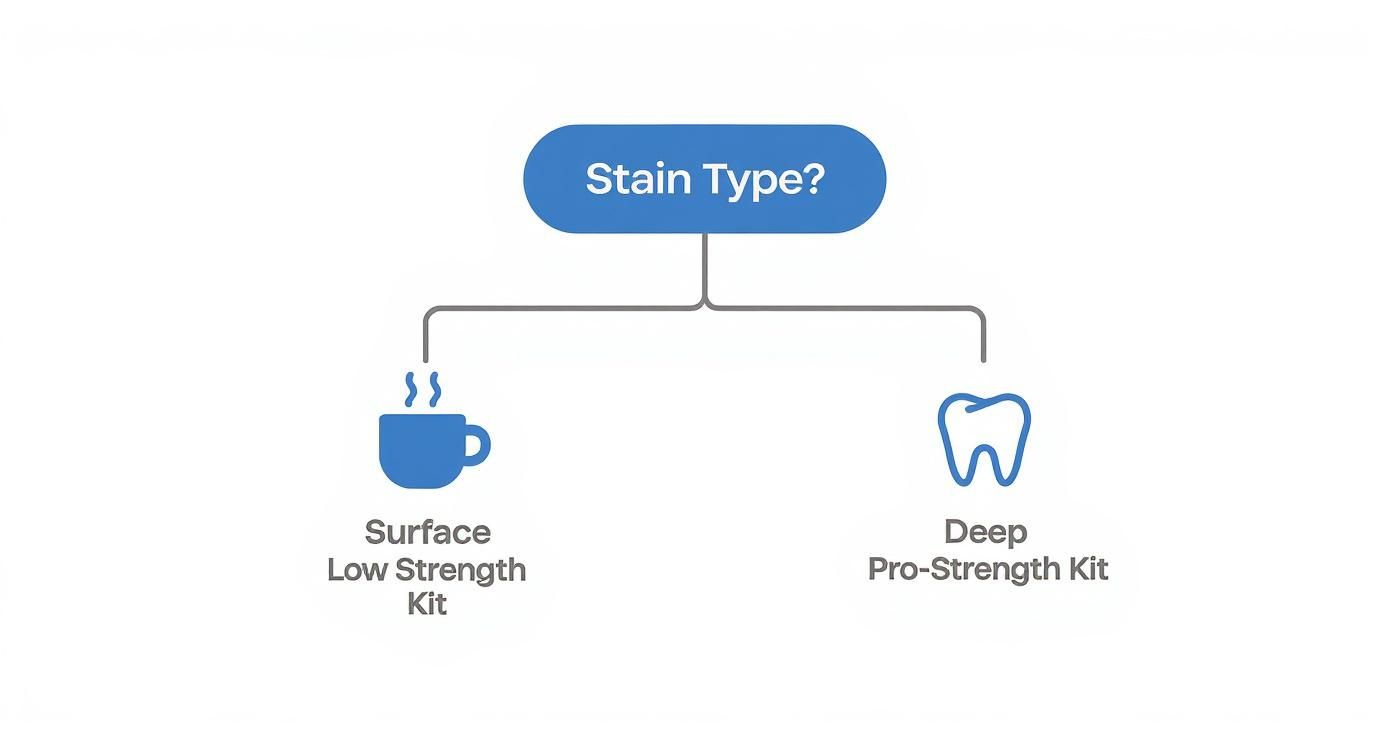
This highlights a crucial point: over-the-counter kits are really only built for the most superficial discolouration. Deeper, more stubborn stains will always need a professional-grade solution to see any real change.
LED Whitening Kits: The Technology Question
LED whitening kits are the ones you see all over social media, often positioned as a high-tech shortcut to a brighter smile. They usually come with a whitening gel and a mouthguard-style tray that emits a blue LED light. The marketing claim is that this light "activates" the gel, making it work faster and more effectively.
While the blue light in at-home kits looks futuristic, there is limited independent scientific evidence to suggest it significantly enhances the whitening process of the low-concentration gels sold in the UK. Its primary effect is often psychological, making the user feel like a more powerful treatment is occurring.
Best For:
Anyone drawn to a gadget-led process who is only looking to tackle very light surface stains. The experience can feel more 'professional' than just using strips, and that appeals to a lot of people.
Real-World Limitations:
The problem isn't the light; it's the gel. These kits are still bound by the 0.1% hydrogen peroxide legal limit. No amount of blue light can magically turn a weak, legally-compliant gel into a powerhouse whitener. On top of that, the generic trays often fit poorly, which can lead to gum irritation and splotchy results—the same issues you get with other one-size-fits-all methods. The tech rarely delivers results that are any better than other over-the-counter options.
UK At-Home Teeth Whitening Kit Comparison
To make things even clearer, this table lays out a side-by-side comparison of the at-home whitening systems you can buy in the UK. I've broken it down by the practical things that actually matter when you're deciding what to spend your money on.
| Kit Type | Best For | Typical UK Price Range | Potential Effectiveness | Ease of Use | Common Issues |
|---|---|---|---|---|---|
| Whitening Strips | Minor surface stains on straight teeth; quick touch-ups. | £20 – £50 | Low | Very Easy | Uneven results; poor fit; slips off teeth. |
| Gels & Pens | Targeting individual teeth or specific spots. | £15 – £40 | Very Low | Moderate | Gel gets washed away by saliva; inconsistent contact. |
| LED Kits | Users seeking a tech-focused experience for light stains. | £40 – £120 | Low | Moderate | Ill-fitting trays; weak gel; light has minimal effect. |
| Dentist-Led (e.g., Toothfairy) | Lasting, noticeable results for moderate to deep stains. | £150 – £400+ | High | Easy (with guidance) | Higher initial cost; requires a dental consultation. |
Ultimately, while over-the-counter kits are cheap and easy to find, their effectiveness is fundamentally limited by UK law. It's best to think of them as tools for minor cosmetic touch-ups, not transformative whitening treatments. For anyone seeking significant, safe, and lasting results, the path almost always leads to professionally supervised treatments that can legally and safely use more powerful whitening agents.
The Professional Advantage of Dentist-Led Whitening
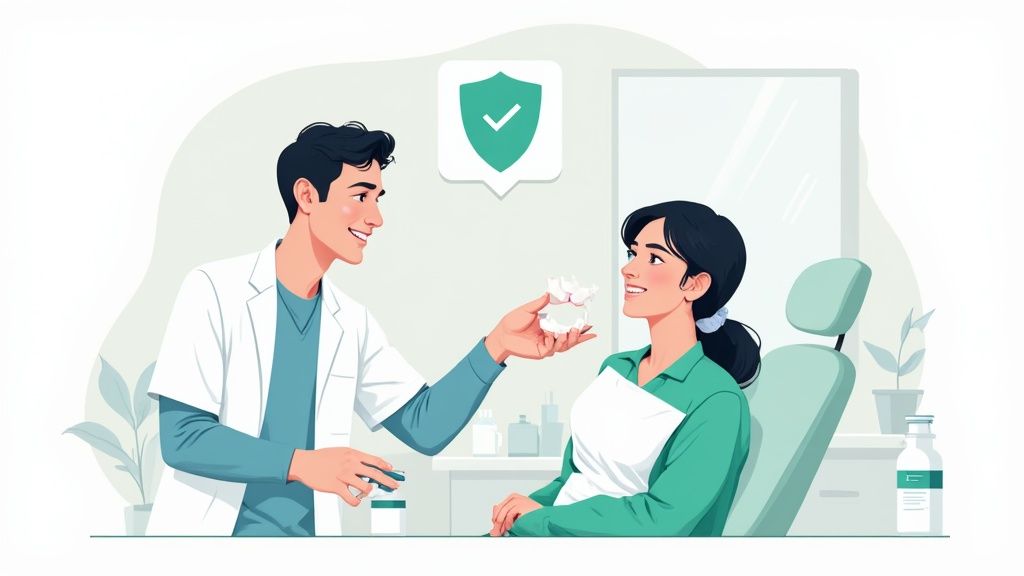
While the promise of a quick fix from an over-the-counter kit is tempting, the results often fall flat. This is where dentist-supervised whitening enters a completely different league, bringing a level of safety, effectiveness, and personalisation that shop-bought products simply can't match. The real difference isn't just the gel; it's the professional oversight.
Moving from a generic kit to a dentist-led system means you’re upgrading from a one-size-fits-all guess to a treatment designed for your teeth and your teeth alone. This professional advantage is the key to achieving a genuinely brighter smile that’s both noticeable and long-lasting—all done safely and predictably.
The Power of Customisation and Prescription Gels
The single biggest game-changer with professional whitening is the custom-fitted trays. Forget the flimsy, boil-and-bite trays from at-home kits; these are crafted from a precise mould of your own teeth, and that bespoke fit is crucial for two reasons.
First, it ensures the whitening gel gets into every nook and cranny, making even, consistent contact with the entire surface of each tooth. This meticulous coverage is what prevents the patchy, disappointing results you often see with strips or generic trays that miss the curved edges and gaps between teeth.
Second, that snug fit creates a perfect seal along your gum line. This stops the powerful whitening gel from oozing out and irritating or burning your sensitive gums. It’s this combination of total coverage and total protection that no off-the-shelf product can ever hope to replicate.
The real magic of professional whitening isn't just about a stronger gel. It's the custom-fitted tray that delivers it. This guarantees every part of your smile gets consistent treatment while protecting your gums, leading to results that are both beautifully uniform and comfortable to achieve.
On top of that, only a dentist can legally prescribe whitening gels containing up to 6% hydrogen peroxide for home use in the UK. That’s a concentration 60 times stronger than the 0.1% limit on products you can buy in a shop. This prescription-strength formula has the power to break down deep, stubborn stains from years of coffee, tea, or red wine, delivering dramatic results that weaker gels just can’t touch.
A Smarter, More Affordable Approach with Toothfairy
Traditionally, getting this level of care meant booking multiple expensive and time-consuming appointments at a dental practice. For many, that barrier was enough to push them towards less effective DIY options. But modern dental care has found a way to bridge that gap.
This is exactly where Toothfairy offers a smarter solution. We’ve blended the convenience of an at-home system with the essential safety and potency of professional dental guidance. The whole process is designed to be straightforward and effective, making professional-grade whitening more accessible than ever before.
Here’s how it works:
- Online Consultation: It all starts with a simple online chat with a qualified UK dentist to make sure whitening is a safe and suitable option for you.
- Impression Kit: We pop an at-home kit in the post for you to take precise moulds of your teeth.
- Custom Trays: Using your moulds, our lab creates your personal, custom-fitted whitening trays.
- Professional Gels: We then send your trays directly to your door, along with the prescription-strength whitening gels.
This model cuts out the high overheads of clinic appointments without ever compromising on professional standards. It’s the perfect answer to the limitations of both weak over-the-counter products and pricey traditional cosmetic dentistry. It also provides a far more reliable alternative to treatments from some aligner brands, which may not offer the same direct dental supervision for cosmetic extras.
By connecting you straight to a dentist, Toothfairy ensures your journey to a brighter smile is guided by genuine expertise from start to finish. It’s the intelligent and affordable choice for achieving visible, lasting results you can trust.
Managing the Risks: Sensitivity and Safety First
Getting a brighter smile is a brilliant goal, but it should never come at the expense of your oral health. It’s vital to understand the potential bumps in the road, with tooth sensitivity and gum irritation being the most frequent culprits.
These issues usually pop up for a couple of reasons: either the whitening agent has seeped onto your gums from a poorly fitting tray or strip, or you’ve simply been overdoing it. While the discomfort is almost always temporary, it can certainly take the shine off the experience. The good news is that with a bit of know-how, you can sidestep these problems and make your whitening journey a smooth one.
How to Minimise Sensitivity and Protect Your Gums
A few simple, proactive steps can make all the difference between a comfortable treatment and a painful one. Think of it as preparing the ground before you plant the seeds.
- Switch to a Desensitising Toothpaste: Start using a toothpaste for sensitive teeth about a week before you begin whitening and continue throughout the process. It works by blocking the tiny tubules in your dentine that lead to the nerve, effectively turning down the volume on sensitivity.
- Get the Fit Right: This is where custom-fitted trays really prove their worth. A generic, one-size-fits-all tray is a recipe for gel leakage. A tray that’s been moulded specifically for your teeth creates a perfect seal, keeping the whitening agent exactly where it needs to be and away from your delicate gums.
- Stick to the Plan: It can be tempting to leave the gel on for longer or whiten more often in the hope of faster results. Don't. Over-whitening is a fast track to sensitivity. Follow the schedule your dental professional gives you to the letter.
It's always a good idea to read up on common teeth whitening side effects so you know what to expect and how to handle it.
Who Should Steer Clear of Teeth Whitening?
Teeth whitening isn't for everyone, and diving in without checking first can turn a small dental issue into a big one. This is why a quick check-up with a dentist before you start is non-negotiable.
A professional dental assessment isn't just a box-ticking exercise; it's your most important safety net. It confirms your teeth and gums are healthy enough to handle the treatment, preventing you from aggravating an issue you might not even know you have. It's a fundamental part of any safe, dentist-led service.
You should definitely hold off on whitening if you have any of the following:
- Untreated cavities
- Gum disease (like gingivitis)
- Cracked teeth or exposed roots
- Veneers, crowns, or fillings on your front teeth (these won't change colour, leading to a mismatched smile)
This really underscores the problem with grabbing a DIY kit off the shelf without professional oversight. An initial consultation, which is built into the Toothfairy process, is designed to catch these issues from the outset and protect your health.
With the demand for whiter teeth booming—around four in ten people under 35 in the UK have already whitened their teeth, and 48% more plan to in the next year—this safety-first approach has never been more critical. You can get more insights into the changing demographic for tooth whitening on dentistry.co.uk. This points to a huge number of people who need and deserve access to solutions that are both effective and, most importantly, safe.
Your Teeth Whitening Questions Answered
Diving into teeth whitening can feel a bit daunting, and it's natural to have questions before you start. To cut through the confusion, I've put together answers to some of the most common queries we see from people in the UK. Think of this as your final checklist to make sure you're confident and well-informed.
We’ll cover everything from how long you can expect your new, brighter smile to last, to the nitty-gritty on safety and why you can't just buy the strong stuff at your local chemist.
How Long Will My Teeth Whitening Results Last?
This is the big one, isn't it? The honest answer is: it depends entirely on you. For most people who get their teeth professionally whitened by a dentist, the results can look great for anywhere between six months and two years.
But that timeline can shrink pretty quickly depending on your lifestyle.
- The usual suspects: Coffee, tea, and red wine are the top culprits for new stains. Smoking is another major factor that will yellow your teeth again over time.
- Keep up the good work: The best way to prolong your results is through simple, consistent care. Regular brushing and flossing are non-negotiable, and using a good whitening toothpaste can really help keep surface stains at bay. Your dentist might also suggest a quick top-up treatment every so often to keep things looking fresh.
Basically, the more you look after your teeth post-whitening, the longer you’ll get to enjoy that brilliant smile.
Can Teeth Whitening Treatments Damage My Tooth Enamel?
A very fair and important question. The short answer is no—when done correctly and under a dentist's supervision, teeth whitening is perfectly safe and won't harm your enamel. The active ingredients, like hydrogen peroxide, simply open up the microscopic pores in your enamel to lift out the stains below. Afterwards, your enamel naturally rehydrates and remineralises.
Where people run into trouble is with unregulated products or by overdoing it.
The real danger to your enamel isn't the whitening agent itself. It’s using products that are too abrasive or acidic, or simply whitening too often. A dentist-led plan makes sure you're using a pH-balanced, safe formula on a schedule that works for your teeth, protecting your long-term oral health.
This is exactly why getting a professional opinion first is so critical. A dentist can check that your teeth are healthy enough for the treatment and set you up with a product that's both safe and effective. It's this professional oversight, which is at the heart of services like Toothfairy, that acts as your best defence against any potential problems.
Are Whitening Toothpastes Effective for Deep Stains?
Whitening toothpastes definitely have their place in keeping a smile bright, but it's important to understand what they can and can't do. Most of them work by being slightly abrasive, which helps to scrub off extrinsic (surface) stains.
They are brilliant for tackling the daily build-up from food and drinks, making them a fantastic maintenance tool after you’ve had a professional treatment. What they can't do, however, is change the actual underlying shade of your teeth.
Because they only work on the surface, they are powerless against the deeper, intrinsic stains that sit inside the tooth. To shift those, you need a bleaching agent like peroxide that can get past the enamel—and that’s something you’ll only find in a professional whitening kit.
Why Are Strong Whitening Kits Not Sold in UK Chemists?
Ever wondered why you can't just pick up a high-strength whitening kit with your weekly shop? It all comes down to UK law and consumer safety. The regulations are there for a very good reason: to protect you from misusing powerful chemicals without a professional’s guidance.
In the UK, any whitening product sold over the counter can legally contain no more than 0.1% hydrogen peroxide. That's a safe level for anyone to use, but frankly, it’s not strong enough to make a dramatic difference.
- The Professional Difference: Dentists, however, can legally prescribe at-home whitening gels containing up to 6% hydrogen peroxide.
- Safety First: That 60x stronger concentration requires a proper dental check-up first. A dentist needs to confirm your teeth and gums are healthy and provide custom-fitted trays to ensure the powerful gel stays on your teeth and away from your sensitive gums.
This legal framework ensures powerful treatments are used safely, and it perfectly illustrates the value of modern dental services that connect you with a dentist online. It’s a much smarter, safer, and more effective route to cosmetic whitening than anything you’ll find on the high street.
Ready for a noticeably brighter smile, safely and effectively? Toothfairy connects you with UK-registered dentists to provide custom-fitted trays and prescription-strength whitening gels, all from the comfort of your home. Get the professional results you deserve.
Start your journey to a whiter smile today at Toothfairy
Last updated on November 20, 2025

Dr. Deepak
ToothFairy Care Team.
Dr. Deepak
ToothFairy Care Team.
